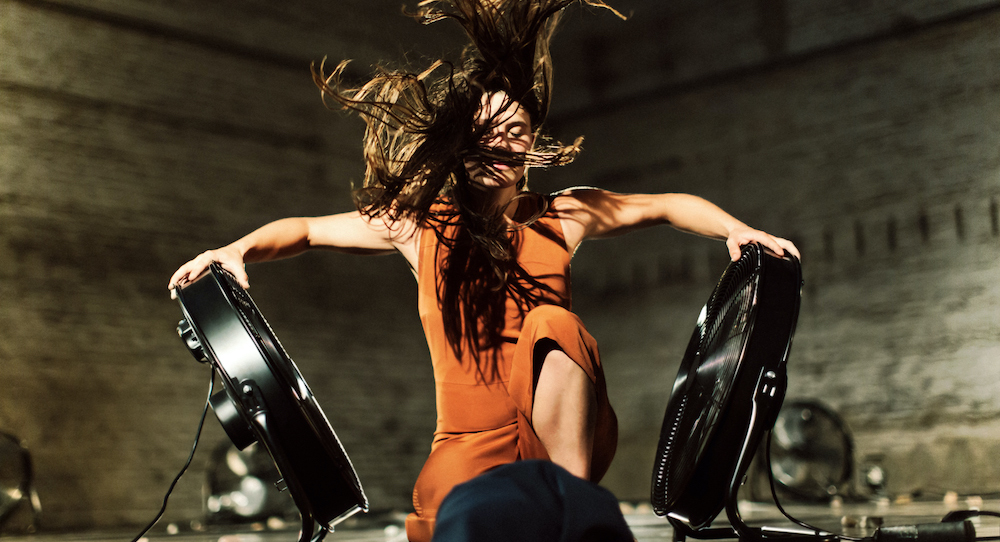Shot at MONOPOL e.V, Berlin, Germany, July 2021.
Streamed online at www.mareikejung.com.
In her solo performance, When Delicacy Unfolds Strength, Mareike Jung “explores dynamics and effects of power in the eye of the storm.” Surrounded by a dense fog, the performer enters a ring of 12 identical fans facing outward. She turns them on methodically, clockwise, one by one, expelling the fog from the center and then turning the fans inward. The only text in the piece is delivered via voiceover (German with English subtitles) as she walks the circular path within the fans. While the substance of the text is somewhat cryptic, its matter of fact delivery and clear placement at the beginning of the piece demand to be made much of. In a mysterious ancestral realm governed by recursive cycles, “mother of… mother of… mother of…” evolves to “daughter of… daughter of… daughter of…” until the cycle terminates in “a child,” a gender neutral entity that has perhaps finally been freed. “Unbreak the circle. Give me a break,” the calm voice requests. Rather than connoting comfort, the phrase “you are not alone” feels stifling, crowded within a dense generational weave which must be somehow dissipated, much like the fog the piece began with. “That heaviness that isn’t mine.”
A tribal drumming rhythm then animates both the space and Jung’s body, intensifying from rhythmic undulations into a full-fledged groove. The body language throughout the rest of the piece is low, contracted and earthy. She tosses her long dark hair, finding mesmerizing ways to suspend it within the intersecting winds. She breaks from her meditative trance and makes tableaus with individual fans, holding her hands in highly particular positions and making careful adjustments that are equal parts intentional and inscrutable. The delicate varieties of spiritual experience that Jung extracts from these mechanical objects is remarkable. She showers herself in ancestral air while holding a fan above her head. She positions herself between dueling fans, twin pincers of time negating each other to pressurize her meditative state. Soon, she begins dropping stones from the long vest of her costume, scattering them in a wide ring within the circle of fans. The suggestion that this may be an elaborate magic rite has been cemented.
She traces the floor with her limbs, collecting the stones with languid gestures, massaging the ground in soft arcs until the stones create a smaller circle in the middle of the floor. She stares for a moment, perhaps forlornly, at the stone circle. The viewer wonders whether she has in fact escaped those baleful cycles until –– aha! –– fire (or at least smoke) is conjured from the center in a tall billowing sheet of white. “Between tailwing and pushback, a breeze of the past blows towards possible futures and brings lightness to the heaviness we carry even if it isn’t ours. Who moves what? What moves us?” The advent of primordial magic forces her gaze skyward as the sheet spirals toward the heavens only to flutter down, again and again. She enters the flame, manipulates it, tears it from the ground, and they dance together, fire and body, in the dim light. The viewer feels a gentle longing for the sheet to continue upward, no longer subject to the heaviness of earthly gravity. When she exits the circle, the flames continue dancing as if to say, “We don’t need you to carry our life.” The tables abruptly turn when Jung flicks off the power strip and the fanning flux slows to a stop; the sheet collapses, her control reasserted before she calmly exits the space.
By the end of the piece, the viewer has been taken through an intimate ritual whose implications fan out into the distance. The intensity, the almost trance-like submission to “what must be done” lingers like a trace, an aura that the viewer carries with them, back into the repetitive cycles that define everyday reality, possibly as a token of hope. While the setting and videography of the performance complemented the work, I am very curious about how this piece might interact with a live audience. Would viewers be seated in the round? If so, how would seeing the faces of fellow audience members through the mist and wind add to or change the meaning of the piece? I am eager to see how a live audience will further bring this piece to life.
By Charly Santagado and Niko Popow of Dance Informa.

















